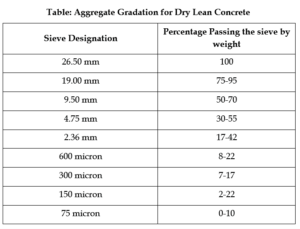DRY LEAN CONCRETE is cement concrete with low slump as well as low cement which is being laid as a first layer for rigid pavement over sub-base (GSB) , rolled & compacted by mechanical means.We will discuss with all sections one by one as per following order:
- GENERAL
- REFERENCE
- EQUIPMENT WITH ESSENTIAL FEATURES
- MANPOWER REQUIREMENTS
- MATERIALS
- TRIAL STRETCH
- QUALITY CONTROL TESTING & ACCEPTANCE
- SAFETY REQUIREMENTS /MEASURES
1.GENERAL
This work should be carried out accordance with the wants of Contract Specifications and in conformity with the lines, grades , drawings or as directed by the Engineer. The work will include furnishing of all plant and equipment, materials , labour and performing all operations, in reference to the work as approved by the Engineer.
The design parameters of dry lean concrete , if any will be as stipulated in the contract drawings.
2. REFERENCE
i) Clause 600 of MORT&H – 5th Edition
ii) IRC:SP: 49-2014
iii) IS: 16714-2018
iv) Relevant Approved Drawings
3. EQUIPMENT WITH ESSENTIAL FEATURES
i) Batching Plant
ii) Paver with Electronic Sensor
iii) Dump Trucks
iv) Water Tanker
v) 8-10 Tonne Roller
vi) Hand Tools: Shovels, Broom, Wire brush, Straight edge
vii) Testing Equipment’s: 20 cm dia Density cone, Vibrating Hammer, Cube Moulds, Thermometer.
4. MANPOWER REQUIREMENTS
i) Site Engineer
ii) Surveyor (With Team)
iii) Operators, Supervisors and Laying Team
5. MATERIALS
5.1 Source of Materials
Source the approval of material should be obtained from the Engineer at least 45 days before the scheduled commencement of the work. If later it is proposed to obtain the materials from a different source, Engineer will be notified for his approval at least 45 days before such materials are to be used.
5.2 Cement
Following sorts of cement could also be used with prior approval of the Engineer.
Ordinary Portland Cement 53 Grade IS:8112 Cement to be used may rather be obtained in bulk form. It will be stored in accordance with stipulations contained in Clause 1014.
5.3 Ground Granulated Blast Furnace Slag
GGBS should be used from approved source & complying the requirements of IRC SP: 49-2014
5.4 Aggregates
Aggregates for lean concrete will be crushed material complying with IS: 383. The aggregates will not be alkali reactive. The limits of deleterious materials will not exceed the requirements set out in IS: 383.
a)Coarse aggregate
Coarse aggregates will consist of clean, hard, strong, dense, non-porous and durable pieces of crushed stones or crushed gravel . The maximum size of the coarse aggregate will be 26.5 mm. The water absorption of coarse aggregate shall not exceed 3%.
b)Fine aggregate
The fine aggregate will consist of clean, natural sand or crushed stone sand or a combination of the two and will conform to IS: 383. Fine aggregate will be free from soft particles, clay, shale, loam, cemented particles, mica, organic and other foreign matter. The water absorption of coarse aggregate shall not exceed 3%.
The material after blending will conform to the grading as indicated in Table -1 of IRC SP 49-2014

5.5 WATER
Water used for mixing and curing of concrete will be clean and free from injurious amounts of oil, salt, acid, substance or other substances harmful to the finished concrete. It will meet the requirements stipulated in IS: 456.
5.6 Proportioning of Materials for the Mix
The mix will be proportioned with a maximum aggregate cement ratio of 14:1. The water content will be adjusted to the optimum as per Clause 4.2 of IRC SP 49 for facilitating compaction by rolling. The strength and density requirements of concrete will be determined in accordance with Clause 7.1 of IRC SP 49-2014 by making trial mixes.
5.7 Cement Content
The minimum cementitious content in the lean concrete will not be less than 140 kg/cum. of concrete. If using GGBS minimum cement content shall not be less than 100 kg/m3.If this minimum cement content is not sufficient to produce concrete of the specified strength, it will be increased as necessary to obtained the strength.
5.8 Concrete strength
The average compressive strength of each consecutive group of 5 cubes made in accordance with IR: SP:49-2014 will not be less than 7 MPa at 7 days. In addition, the minimum compressive strength of any individual cube will not be less than 5.5 MPa at 7 days. The design mix complying with these requirements shall be worked out before start of work.
5.9 Sub-grade
The sub-grade will conform to the grades and cross sections shown on the drawings and will be uniformly compacted to the design strength in accordance with these specifications and specification stipulated in the contract. The lean concrete sub-base shall not be laid on a poor sub-grade , if any must be properly back-filled and compacted as per specification. As far as possible, the construction traffic will be avoided on the prepared sub-grade. A day before placing of the sub-base, the sub-grade surface will be given a light sprinkling of water and rolled with one or two passes of a smooth wheeled roller after a lapse of 2-3 hours in order to stabilize loose surface and then check for compliance.
5.10 Construction
The pace and program of the lean concrete sub-base construction will be matching suitably with the program of construction of the cement concrete pavement over it. The sub base will be overlaid with cement concrete pavement only after 7 days after sub-base construction.
5.11 Batching and mixing
The batching plant will be capable of proportioning the materials by weight, each type of material being weighed separately. The cement from the bulk stock will be weighed separately from the aggregates. The capacity of batching and mixing plant should be at least 25 % higher than the proposed capacity for the laying arrangements & batching and mixing plant should have necessary automatic controls to ensure accurate proportioning and mixing. Other types of mixers will be got approved subject to demonstration of their satisfactory performance during the trial length.
6.0 Trial Stretch
A trial stretch shall be made to the required width and minimum of 60 metre length . The trial length shall contain construction of at least one transverse construction joint involving hardened concrete and sub-base to be laid subsequently, so as to demonstrate the soundness of the procedure. In one day not more than 30 m of trial stretch shall be laid. The in-situ density of the freshly laid concrete shall be determined by sand replacement method by making 3 density holes at equal distances that diagonally bisects the trial length, these shall not be made in the strip of 500 mm from the edges. The average of these shall be considered as 100%, and with this the field density of the regular work shall be compared. The hardened concrete may be cut for 3m width in the trial length and reversed to check the bottom surface for any segregation or honey-combing, if found necessary adjustments shall be made in the mix design.
6.1 Transportation and placing
The plant mix concrete shall be transported by sufficient number of trucks to ensure continuous, uniform supply of concrete to feed the laying Equipment. The mix shall be protected from the weather, by covering the tippers/dumpers with tarpaulin during the transit. The lean concrete shall be laid to the required widths, grades,camber and thickness with self-propelled, electronic sensor or mechanical paver.
The Equipment shall be capable of laying the materials in an even manner without segregation, to the specified thickness after the compaction. The paving machine should have facilities to give good initial compaction.
6.2 Compaction
The compaction shall commence as soon as the concrete laid and levelled to the full width till there is no further movement under the roller and the surface is closed. In addition to the number of passes required for compaction, there shall be a pass without vibration as preliminary pass and another at the end as final pass. The minimum dry density obtained shall be 97% of that achieved in trial length, and at a distance of 500 mm from edge it shall be 95% of that achieved in the trial length. The finished surface should be inspected immediately, and all loose, segregated or defective areas if any ,shall be corrected by using fresh lean concrete. Honeycombed areas, any level/ thickness deficiency and surface irregularities shall be corrected by concrete with 10 mm and down aggregates. Special care and attention shall be exercised during compaction near joints, kerb, channels, side forms, around gullies and manholes.
7.0 Quality Control Testing and Acceptance
- Curing
As soon as the lean concrete surface is completed, curing shall commence.
a) Curing shall be done by covering the surface by hessian cloth in two layers which shall be kept continuously moist for 7 days by sprinkling water.
b) If water-curing is not possible, the curing shall be done by spraying with liquid curing compound. The curing compound shall be white pigmented type with water retention index of minimum 90 percent, when tested in accordance with the test method given in Annexure-A of IRC SP 49 -2014 To check the efficiency of the curing compound, the supplier shall be required to provide the test certificate from a recognized laboratory. Curing compound shall be sprayed immediately after when rolling is complete & the surface shall also be covered with wet hessian for three days.
2)Tolerance
The tolerances for thickness shall be ± 10 mm.
3)Density
The dry density of the laid material shall be determined from density holes at locations equally spaced along a diagonal that bisects each 2000 sq.m or part thereof, of material laid each day. It shall not be less than 97% of design density .The control of strength shall be exercised by taking samples of dry lean concrete for making cubes at the rate of 3 samples for each 1000 sq.m or part thereof laid each day. The cube samples shall be compacted, cured and tested in accordance with IS: 51 6.
8.Safety Requirements/Measures
DLC laying team will wear personal protective equipment while producing, transporting and laying the mix. All safety measures will be taken as per approved plan.

